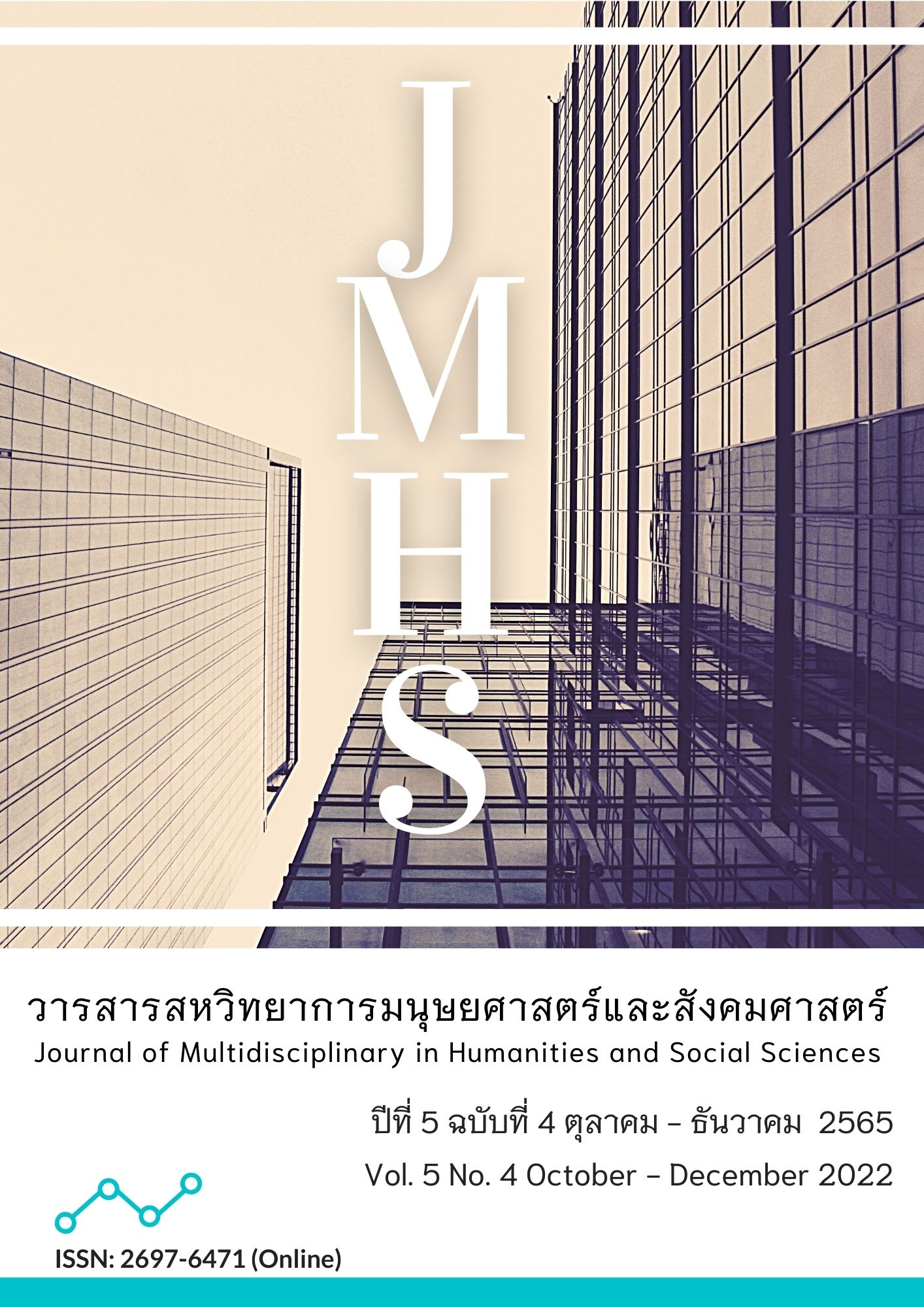บทบาทการเผยแผ่พระพุทธศาสนาของพระสาวกในพระสุตตันตปิฎก
Main Article Content
บทคัดย่อ
บทความนี้มีวัตถุประสงค์ 3 ประการ คือ 1) เพื่อศึกษาประวัติและคุณสมบัติของพระสาวกองค์สำคัญ 2) เพื่อศึกษาวิธีการและการปฏิบัติเพื่อที่จะบรรลุธรรมของพระสาวก และ 3) เพื่อวิเคราะห์บทบาทการเผยแผ่พระพุทธศาสนาของพระสาวกในพระสุตตันตปิฎก เป็นการวิจัยเชิงคุณภาพ โดยศึกษาข้อมูลจากคัมภีร์พระพุทธศาสนาเถรวาทและเอกสารที่เกี่ยวข้องนำข้อมูลที่ได้มารวบรวม วิเคราะห์ สรุปเรียบเรียงบรรยายเชิงพรรณนา
ผลการวิจัย พบว่า 1) คุณสมบัติก่อนบรรลุธรรมหรือก่อนที่จะเข้ามาบวชในพระพุทธศาสนาของพุทธสาวกมีชาติกำเนิดมาจากทุกชนชั้นวรรณะ เมื่อได้รับการมาบวชในพระพุทธศาสนา จะต้องปฏิบัติอยู่ในกรอบของพระธรรมวินัย 2) วิธีการและการปฏิบัติเพื่อที่จะบรรลุธรรมของพระสาวก พบว่า สังคมอินเดียในอดีตการออกบวชเป็นสิ่งจำเป็นสำหรับชีวิตในการที่จะแสวงหาโมกขธรรม หากผู้ใดต้องการหลุดพ้นจากภาระหน้าที่ที่ถูกมอบหมายหรือถูกกำหนดโดยสังคมจารีตประเพณีและวัฒนธรรมก็ต้องแสวงหาความสุขสงบโดยการออกบวชและศึกษาศิลปวิทยาอยู่ในสำนักที่บรรพบุรุษหรือตนเองเลื่อมใสศรัทธา แล้วบำเพ็ญเพียรภาวนา ช่วยถ่ายทอดความรู้ของครูอาจารย์ต่อไปหรือไม่ก็ขึ้นอยู่กับจริตหรือวิสัยทัศน์ของแต่ละบุคคล 3) วิเคราะห์บทบาทการเผยแผ่พระพุทธศาสนาของพระสาวกในพระสุตตันตปิฎก พบว่า หลังจากบรรลุเป็นพระอรหันต์แล้ว พุทธสาวกทั้งหลายต่างก็ประพฤติปฏิบัติตามปฏิปทาที่ตนเองถนัด การช่วยกันเผยแผ่พระพุทธศาสนาหรือโดยการปลีกวิเวกไปตามสถานที่ที่ตนเองปรารถนาตามลำพังบ้างเที่ยวจาริกไปตามสถานที่ต่างๆ กับพระภิกษุบริวารบ้าง ตามเสด็จพระพุทธเจ้าเพื่อสนองงานที่ตนเองมีความสามารถ ปฏิบัติตามหลักธรรมที่ตนเองยึดถือเป็นวัตรปฏิบัติ
Article Details

อนุญาตภายใต้เงื่อนไข Creative Commons Attribution-NonCommercial-NoDerivatives 4.0 International License.
ทัศนะและความคิดเห็นที่ปรากฏในวารสาร ถือเป็นความรับผิดชอบของผู้เขียนบทความนั้น และไม่ถือเป็นทัศนะและความรับผิดชอบของกองบรรณาธิการ
เอกสารอ้างอิง
บรรจบ บรรรณรุจิ. (2535). อสีติมหาสาวก. กรุงเทพฯ: ธรรมสภา.
พระบุญสิริ มุ่งสุข และ วิโรจน์ คุ้มครอง. (2565). การบำเพ็ญบารมีและการบรรลุธรรมของพระเมฆิยเถระ. วารสารสหวิทยาการมนุษยศาสตร์และสังคมศาสตร์, 5(1), 308-317. https://so04.tci-thaijo.org/index.php/jmhs1_s/article/view/256923
พระปลัดคมศักดิ์ รุ่งศิริ และ พระปลัดสมชาย ดำเนิน. (2565). พระธรรมกถึกกับการเผยแผ่พระพุทธศาสนาในสังคมไทย. วารสารนวัตกรรมการจัดการศึกษาและการวิจัย, 4(1), 18-28. https://so02.tci-thaijo.org/index.php/jemri/article/view/250687
พระปลัดสมหวัง ศรีเพ็ญ และ วิโรจน์ คุ้มครอง. (2565). การวิเคราะห์ทุกข์ในอฆมูลสูตรที่มีความ สัมพันธ์ต่อการเจริญวิปัสสนาภาวนา. วารสารสหวิทยาการมนุษยศาสตร์และสังคมศาสตร์, 5(2), 654–663. https://so04.tci-thaijo.org/index.php/jmhs1_s/ article/view/256947
พระพรหมคุณาภรณ์ (ป.อ. ปยุตฺโต). (2551). พจนานุกรมพุทธศาสน์ ฉบับประมวลศัพท์. (พิมพ์ครั้งที่ 12). กรุงเทพฯ: โรงพิมพ์มหาจุฬาลงกรณราชวิทยาลัย.
พระพรหมคุณาภรณ์ (ป.อ.ปยุตฺโต). (2556). พุทธวิธีในการสอน. (พิมพ์ครั้งที่ 18). กรุงเทพฯ: พิมพ์สวย.
พระมหากิตติณัฏฐ์ สุกิตฺติเมธี. (2564). การวิเคราะห์แนวทางงดเว้นจากความเสื่อมในปราภวสูตร. วารสารสหวิทยาการมนุษยศาสตร์และสังคมศาสตร์, 4(1), 84-95. https://so04.tci-thaijo.org/index.php/jmhs1_s/article/view/245026
พระสมชาย บัวแก้ว, พระมหาบุญศรี วงค์แก้ว และ สุเชาวน์ พลอยชุม. (2564). อภิสมาจาร: กระบวน การพัฒนาบุคลิกภาพตามแนวพระพุทธศาสนา. วารสารศิลปการจัดการ, 5(3), 895-907. https://so02.tci-thaijo.org/index.php/jam/article/view/251384
สุนทร ณ รังษี. (2530). ปรัชญาอินเดีย : ประวัติและลัทธิ. กรุงเทพฯ: จุฬาลงกรณ์มหาวิทยาลัย.
มหาจุฬาลงกรณราชวิทยาลัย. (2539). พระไตรปิฎกภาษาไทย ฉบับมหาจุฬาลงกรณราชวิทยาลัย. กรุงเทพฯ: โรงพิมพ์มหาจุฬาลงกรณราชวิทยาลัย.
มหาจุฬาลงกรณราชวิทยาลัย. (2552). อรรถกถาภาษาไทย ฉบับมหาจุฬาลงกรณราชวิทยาลัย.กรุงเทพฯ: โรงพิมพ์มหาจุฬาลงกรณราชวิทยาลัย.
อรชร ไกรจักร์, เเม่ชีกฤษณา รักษาโฉม และ พระมหาวรัญธรณ์ ญาณกิตฺติ. (2564). บุคลิกภาพของพระภิกษุตามหลักเวสารัชชกรณธรรม. วารสาร มจร บาฬีศึกษาพุทธโฆสปริทรรศน์, 7(3), 113–125. https://so05.tci-thaijo.org/index.php/Palisueksabuddhaghosa/article/view/253499
Chanthathong, S. (2021). The Significance of the Right View (Sammaditthi) in Theravada Buddhism. Journal of International Buddhist Studies, 12(1), 61-70. http://www.ojs.mcu.ac.th/index.php/JIBS/article/view/6693
Damnoen, P. S., Siri, P., Supattho, P. S., & Kaewwilai, K. (2021). The Development of Student Characteristics in According to the Nawaluk Framework of the Buddhist integration of Buddhapanya Sri Thawarawadee Buddhist College. Asia Pacific Journal of Religions and Cultures, 5(2), 126–135. https://so06.tci-thaijo.org/index.php/ajrc/article/view/249662
Tan, C. C., & Damnoen, P. S. (2020). Buddhist Noble Eightfold Path Approach in the Study of Consumer and Organizational Behaviors. Journal of MCU Peace Studies, 8(1), 1–20. https://so03.tci-thaijo.org/index.php/journal-peace/article/view/235080


